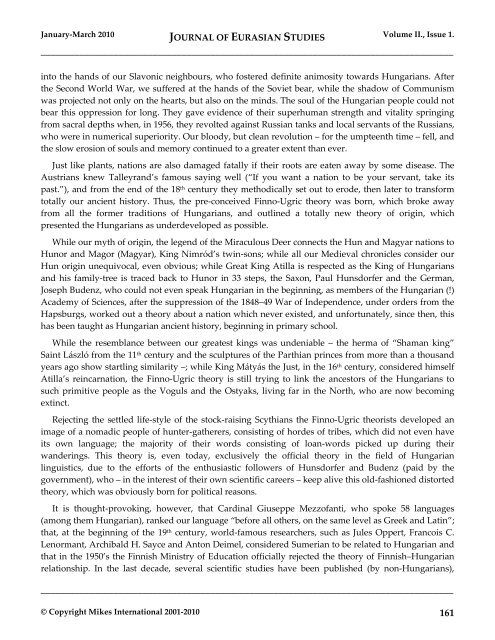EurasianStudies_0110..
EurasianStudies_0110..
EurasianStudies_0110..
You also want an ePaper? Increase the reach of your titles
YUMPU automatically turns print PDFs into web optimized ePapers that Google loves.
January-March 2010 JOURNAL OF EURASIAN STUDIES Volume II., Issue 1.<br />
_____________________________________________________________________________________<br />
into the hands of our Slavonic neighbours, who fostered definite animosity towards Hungarians. After<br />
the Second World War, we suffered at the hands of the Soviet bear, while the shadow of Communism<br />
was projected not only on the hearts, but also on the minds. The soul of the Hungarian people could not<br />
bear this oppression for long. They gave evidence of their superhuman strength and vitality springing<br />
from sacral depths when, in 1956, they revolted against Russian tanks and local servants of the Russians,<br />
who were in numerical superiority. Our bloody, but clean revolution – for the umpteenth time – fell, and<br />
the slow erosion of souls and memory continued to a greater extent than ever.<br />
Just like plants, nations are also damaged fatally if their roots are eaten away by some disease. The<br />
Austrians knew Talleyrand’s famous saying well (“If you want a nation to be your servant, take its<br />
past.”), and from the end of the 18 th century they methodically set out to erode, then later to transform<br />
totally our ancient history. Thus, the pre-conceived Finno-Ugric theory was born, which broke away<br />
from all the former traditions of Hungarians, and outlined a totally new theory of origin, which<br />
presented the Hungarians as underdeveloped as possible.<br />
While our myth of origin, the legend of the Miraculous Deer connects the Hun and Magyar nations to<br />
Hunor and Magor (Magyar), King Nimród’s twin-sons; while all our Medieval chronicles consider our<br />
Hun origin unequivocal, even obvious; while Great King Atilla is respected as the King of Hungarians<br />
and his family-tree is traced back to Hunor in 33 steps, the Saxon, Paul Hunsdorfer and the German,<br />
Joseph Budenz, who could not even speak Hungarian in the beginning, as members of the Hungarian (!)<br />
Academy of Sciences, after the suppression of the 1848–49 War of Independence, under orders from the<br />
Hapsburgs, worked out a theory about a nation which never existed, and unfortunately, since then, this<br />
has been taught as Hungarian ancient history, beginning in primary school.<br />
While the resemblance between our greatest kings was undeniable – the herma of “Shaman king”<br />
Saint László from the 11 th century and the sculptures of the Parthian princes from more than a thousand<br />
years ago show startling similarity –; while King Mátyás the Just, in the 16 th century, considered himself<br />
Atilla’s reincarnation, the Finno-Ugric theory is still trying to link the ancestors of the Hungarians to<br />
such primitive people as the Voguls and the Ostyaks, living far in the North, who are now becoming<br />
extinct.<br />
Rejecting the settled life-style of the stock-raising Scythians the Finno-Ugric theorists developed an<br />
image of a nomadic people of hunter-gatherers, consisting of hordes of tribes, which did not even have<br />
its own language; the majority of their words consisting of loan-words picked up during their<br />
wanderings. This theory is, even today, exclusively the official theory in the field of Hungarian<br />
linguistics, due to the efforts of the enthusiastic followers of Hunsdorfer and Budenz (paid by the<br />
government), who – in the interest of their own scientific careers – keep alive this old-fashioned distorted<br />
theory, which was obviously born for political reasons.<br />
It is thought-provoking, however, that Cardinal Giuseppe Mezzofanti, who spoke 58 languages<br />
(among them Hungarian), ranked our language “before all others, on the same level as Greek and Latin”;<br />
that, at the beginning of the 19 th century, world-famous researchers, such as Jules Oppert, Francois C.<br />
Lenormant, Archibald H. Sayce and Anton Deimel, considered Sumerian to be related to Hungarian and<br />
that in the 1950’s the Finnish Ministry of Education officially rejected the theory of Finnish–Hungarian<br />
relationship. In the last decade, several scientific studies have been published (by non-Hungarians),<br />
_____________________________________________________________________________________<br />
© Copyright Mikes International 2001-2010 161

















